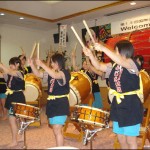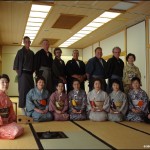Last fall at the AKA Grand Nationals in Ocean Shores, John and I were sitting down to breakfast Saturday morning. It was completely awful outside with a downpour coming down, coupled with really high winds. It was a bit of a letdown as we’d wanted to fly the day away, but this being the Pacific Northwest, you somewhat get used to this kind of thing. As we were sitting there, I glanced outside and said to John, “You know, there’s just enough room for us to fly directly in front of the Shiloh’s restaurant for a little while”. John got that twinkle in his eye and after collecting the appropriate rain gear and team members, off we went for a quick soaking. There was no agenda beyond simply wanting to fly and have some fun. Unbeknownst to us at the time, Maasaki Modegi and other members of the Drachen Foundation board of directors had come down to have breakfast as we were setting up. After watching us flail about in a monsoon for a couple of hours (laughing throughout!), Modegi-san suggested to Ben D’Antonio that perhps iQuad would be interested in coming to Japan in the spring…
Months later and with the help and guidance of the Drachen Foundation, Revolution and the Japanese Kite Association, 6 members of iQuad (John Barresi, David Hathaway, Steve DeRooy, Mike Kory, Barry Poulter and Jay Nunes) found themselves jetting across the Pacific Ocean to meet up in Tokyo for what would turn into the adventure of a lifetime, with 11 days spent in and around Japan. Also along for the trip Kiyomi Odawa and Dave Baldwin from the Drachen Foundation (Dave acted as camera/video/straight man for us all) and Ben D’Antonio, iQuad’s patron saint at Revolution. The distance involved in the travel is huge and thus, even coming from San Francisco it was a 12 hour flight but despite this, every single one of us was raring to go, once we had gotten our heads around that we’d left at about noon on Friday and had arrived late afternoon on Saturday!
Our first stop that evening was to visit Modegi-san’s Yokatsu restaurant deep in downtown Tokyo. “Yokatsu” food is unique in Japan. Much in the same fashion that asian food has come over to North America and been adapted on some levels, the same happens in reverse. Yokatsu is a “Japanized” version of North American food, with such delights as Hambagoo. Below is a link to a New York Times review of Modegi-san’s beautiful restaurant, which explains it far better than I could. :
As an after dinner treat, Modegi-san took us upstairs to his renowned kite museum. And what a museum it is! In any direction you look, there are dozens of beautiful examples of kites, mostly hand made in Japan. One exception was a Quantum Pro, signed by 2005/2006 World Champions, Team Cutting Edge. Edos, Tsuguras, mini kites, large kites and a small version of Modegi-san’s Rabbit kite, which is one of the three largest kites in the world. We could have easily spent an entire day wandering through the kites he has and I bet we still may have missed some. It’s truly an extraordinary collection of kites so, if you happen to be in Tokyo, I highly recommend a visit to the place.
Further information on the museum can be found here :
http://www.monodukuri-net.com/new/3rd/hakubutsukan/tako/tako_eng.html
After a much needed deep sleep in The Royal Park Hotel in downtown Tokyo, we went for a short walk around the city. Bear in mind that Tokyo is a massively large city. There’s about 35 million people that live in greater area around Tokyo, which is more than the population of Canada, sandwiched into an area about the size of Calgary, in Alberta (for reference, Calgary has 1 million people). I’ll write more about Tokyo later in the article as today’s main order of business was to get the group up to Fujisaki, on the north and of Japan’s main island. A short flight and a short drive, later, we had arrived at Sato-san’s house in Fujisaki itself. This was to be our home for the next few days, and we were wonderfully spoiled the entire time we stayed with her and her husband. Fujisaki is the main area where Fuji apples come from and I dearly wanted to bring a case of that apple juice back with me. Delicious! For me personally, this was also the start of what at the time felt like a simple cold, compounded with some amount of jetlag. We were then whisked off to the opening ceremony banquet for the kite festival we were flying at, an evening that was filled with delicious food, great local entertainment and even a wee bit of indoor kite flying. Oh, and some sake…
The next day found us bouncing around Fujisaki, taking in the sights. We stopped in at a ceremony at the main hub of distribution for Fuji apples, popped into a processing plant for the same apples and eventually ended up at an elementary school. We did three such stops at schools to interact with the kids. We’d answer questions for them on our lives in the US/Canada (What do you eat for breakfast? Was the most common question), and then spend some time either flying indoors or outdoors depending on the location and time allotted for. The kids were thrilled with any of the kite flying we did and they found a consnat source of amusement in both Steve and John’s height. On some levels, this was perhaps one of the more rewarding aspects of the trips, getting a glimpse into the world of the kids we met, and spending time making them smile and laugh with kites, despite having a huge communication gap at times. Thankfully, Modegi-san had provided us with a fantastic local translator who made all of our lives much easier!
Our first afternoon found us whisked off to the local Cultural Center to experience a little Japanese cultural traditions first hand. Somehow, a group of woman managed to wrestle us all into Kimonos, and voila! You have the most unlikely looking bunch of guys, sitting in on an authentic Japanese tea ceremony. While our legs couldn’t take the “proper” sitting position for very long, we thoroughly enjoyed the ceremony. It’s one thing that constantly struck us during our time in Japan, the sense of honouring their traditions and past, whether it’s the older generation passing down the lore to their children, or the children themselves who eagerly learn about their culture, and celebrate it. That evening, we toured an ancient Samurai castle located in Hirosaki, and once more, we were awed by sense of history. In North America, it’s tough to find many cultural sites that are much older than 200 years old, but, everywhere you turn in Fujisaki and Japan in general, you can see another location that may have existed for hundreds of years. In this case, the castle in Hirosaki had been constructed in the 17th century. Unfortunately, we had JUST barely missed the flowering of the cherry blossoms around the castle, but, you could see that when the trees were in full bloom, it’d be a beautiful site quite unlike any other. To top the evening off, we made a stop at a roadside ramen noodle restaurant, just in case we were still a little hungry. And, we were!
The next day brought us to the Fujisaki Kite Festival, held just down the road from where we we were staying. It’s a local festival, held yearly and features a local kite called a tsugura . As we were warming up with some flying in what can only be described as an ever changing bowl of wind (it’s one of those times where flying a quad made all the difference in coping with constantly changing winds), we were noticing that we hearing an awful lot of what sounded either like helicopters or small planes flying around, but when we’d look around to find them, they were never to be seen. Some manner of Japanese stealth technonlogy? No, not at all. The Tsugura kite is a rigid, rectangular kite that has a small noise generating ribbon between it’s twp top tips, and when the wind passes in behind this kind of a kite, it makes a low to loud humming noise. We saw all kinds of these kites while we were there, some as small as a foot high to a few over 6 feet high. (Sato-san herself has made the largest Tsugura kite ever made, I’ll detail a little more about this in the next issue). We also got to spend some time with two members of the Japanese quad team called Karasu, who flew a jaw droppingly great routine on a pair of Rev Blasts, not typically a kite associated with ballet performances however, in their hands, they made for a very thrilling routine to watch!
Later that afternoon, after the festival had wrapped up for the day, we all went back to Sato-san’s house once more for a BBQ out on the patio. All manner of raw fish came out, some of it which we ate as sushi, some of which was roasted on the BBQ. Delicious from start to finish, and even the faint hearted amongst us were soon trying things out. I’d highly recommend BBQ’ed scallops, washed down with some sake. The evening found us in downtown Hirosaki, watching a lively parade where the streets were simply packed with people. Stunning float after float drifted past us, often constructed in such a way that they could remove panels of the float if they were coming close to low power lines or light fixtures as they wove down the street.
Unfortunately, the cold I thought I’d picked up earlier in the week was continuing to dog me. Day by day, I was getting more and more stuffed up, first in my sinuses, then onto my nose and eventually migrating into my lungs as well. I’ll tell you what was happening when I finish the second article on our trip to Japan, which will be in the next issue of Kitelife.
Kon Ban Wha,
David Hathaway













